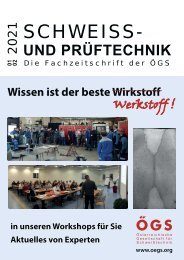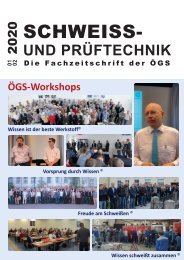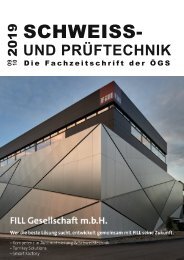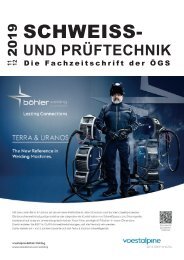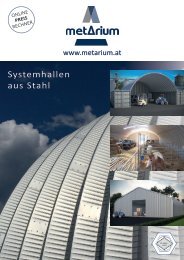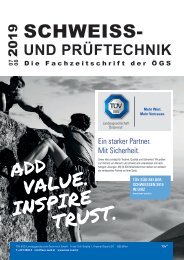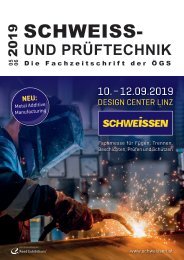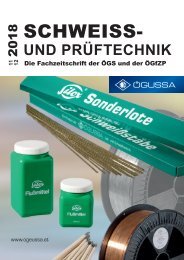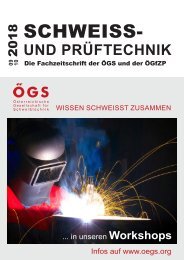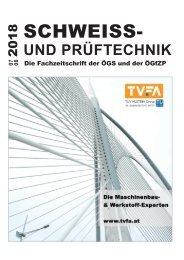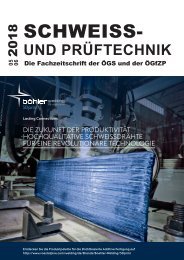Fachzeitschrift_OeGS_03_04_2019
Sie wollen auch ein ePaper? Erhöhen Sie die Reichweite Ihrer Titel.
YUMPU macht aus Druck-PDFs automatisch weboptimierte ePaper, die Google liebt.
Mechanical properties and microstructural study of homogeneous<br />
and heterogeneous laser welds in α, β, and<br />
α + β titanium alloys<br />
• L. Weiss, J. Zollinger, P. Sallamand, E. Cicala, A. Mathieu,<br />
E. Fleury<br />
Heterogeneous welding has been investigated for three different<br />
couples of titanium alloys: α/α + β, α/β, and α + β/β.<br />
Plates of 100 × 60 mm and 1.6 or 1.8 mm thick were welded<br />
with a Yb:YAG laser. Tensile tests show that the resistance<br />
of the heterogeneous welded specimens was generally<br />
controlled by those of the weakest material except for<br />
the α + β/β where the ultimate tensile strength was approximately<br />
equal to the average value of both materials. In<br />
every case, the elongation of the welded sample was found<br />
to be smaller than that of the base metals. The rupture generally<br />
took place outside the weld metal and was found to<br />
be most of the time located in the alloy having the lowest<br />
mechanical properties. Nevertheless, a few large-size porosities<br />
detected by tomography in the α + β/β couple could<br />
explain why rupture for these samples occurred in the weld<br />
bead. For each couple, the porosities were situated at the<br />
board between the heat-affected zone and the molten<br />
zone. EBSD maps and EDX enabled the observation of different<br />
microstructures, which could be correlated to the<br />
heterogeneous composition and diffusion into the melted<br />
bath. When the stable microstructure of one of the couple<br />
alloys is the β phase, the molten zone of the bead consists<br />
of an alternative disposition of thin layers made of large<br />
equiaxed β grains and nano-martensite α′. That is explained<br />
by the weak diffusion of the alloying elements.<br />
Liquid interlayer formation during friction stir spot welding<br />
of aluminum/copper<br />
• A. Regensburg, F. Petzoldt, T. Benss. J.P. Bergmann<br />
The fabrication of dissimilar aluminum/copper joints for<br />
electrical application raises the challenges for conventional<br />
joining technologies. Within the solid-state processes, friction<br />
stir welding (FSW) provides numerous advantages to<br />
realize different joint configurations, especially by minimizing<br />
the heat input and hence the formation of brittle intermetallic<br />
phases. However, the joints also have to provide a<br />
high contact interface with firm bonding in order to provide<br />
a minimal contact resistance. Therefore, joints of 1 mm EN-<br />
CW0<strong>04</strong>A and EN AW1050A with a controlled melt layer formation<br />
were produced by friction stir spot welding (FSSW).<br />
By using a pinless tool and the positioning of copper as the<br />
upper joining partner, local melt formation at the interface<br />
with a eutectic composition was promoted without significant<br />
intermixing, resulting in wetting of the aluminum and<br />
a contact area increase. The rotational speed was varied<br />
between 1800–2400 rpm, in which range samples with up<br />
to 300-μm-thick melt layers were produced. The wetting<br />
effect at the interface shows a positive influence on the<br />
shear strength with ductile failure behavior even at high<br />
layer thickness. The microstructural composition at the interface<br />
showed a eutectic composition for small layer thickness<br />
and an inhomogeneous composition with hypo- and<br />
hypereutectic solidification structures for higher thickness<br />
values. However, the formation of intermetallic compounds<br />
other than CuAl2 was mostly inhibited by the short process<br />
times and high cooling rate.<br />
Welding design methodology for optimization of phase<br />
balance in duplex stainless steels during autogenous<br />
arc welding under Ar–N 2<br />
atmosphere<br />
• A. Rokanopoulou, P. Skarvelis, G. D. Papadimitriou<br />
This study deals with the selection of appropriate welding<br />
parameters during autogenous arc welding of duplex stainless<br />
steels in order to achieve an optimum phase balance of<br />
austenite and ferrite in the as-welded microstructure. Specimens<br />
of duplex stainless steel 2205 with dimensions<br />
(40 × 40 × 10) mm 3 were welded using autogenous arc welding<br />
under 95% Ar + 5% vol. N 2<br />
atmosphere. The weld pool<br />
temperature was measured by non-contact infrared temperature<br />
measurement, the weld bead dimensions were determined<br />
using scanning electron micrographs, and the final<br />
nitrogen concentration was evaluated by optical emission<br />
spectroscopy. The kinetics of nitrogen absorption and desorption<br />
in molten duplex stainless steel was discussed and<br />
all the relevant variables were presented. The effect of welding<br />
current and speed on the final nitrogen concentration<br />
was also discussed. Finally, based on this analysis, a method<br />
was set up which can be used to optimize the phase balance<br />
by using predictive methods of the Ferrite Number, such as<br />
the Welding Research Council (WRC)-92 diagram.<br />
Numerical investigations on the thermal efficiency in<br />
laser-assisted plasma arc welding<br />
• S. Jäckel, M. Trautmann, M. Hertel, U. Füssel, D. Hipp,<br />
A. Mahrle, E. Beyer<br />
Numerical investigations on the thermal efficiency in laserassisted<br />
plasma arc welding (LAPAW) have been carried out<br />
by the combination of a magneto-hydrodynamic (MHD) arc<br />
model and a smoothed-particle-hydrodynamics (SPH) model<br />
of the weld pool. The comparison of the calculated weld<br />
seam cross-sections gained from numerical simulation as<br />
well as experimental examinations shows a good agreement.<br />
By the use of the weld pool model, the sensitivity of<br />
different influencing variables was investigated. The analysis<br />
clearly reveals the major influence of the central heat flux<br />
density on the penetration profile and on the thermal efficiency<br />
of the process. The higher the heat flux of the laser<br />
beam and the higher the constriction of the heat flux profile<br />
of the arc, the higher the thermal efficiency of the process.<br />
SCHWEISS- und PRÜFTECHNIK <strong>03</strong>-<strong>04</strong>/<strong>2019</strong> 67




